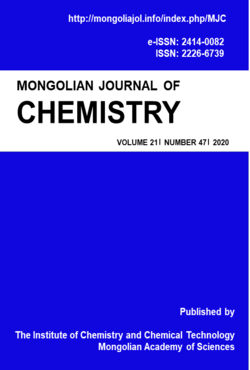Antimicrobial, antioxidant and cytotoxic activity on human breast cancer cells of essential oil from Pinus sylvestris. var mongolica needle
DOI:
https://doi.org/10.5564/mjc.v21i47.1428Keywords:
Pinaceae, B. subtilis, volatile component, α-pineneAbstract
Pinus sylvestris. var mongolica is a major source of timber in Mongolia. The logging process makes many kinds of valuable biomass including bark, cones, and needles, which can be used for obtaining essential oil. The essential oil from the needles of wild growing Pinus sylvestris. var mongolica growing in Mongolia was chemically analyzed and its antibacterial, antifungal and cytotoxic activities were evaluated. The chemical analyses identified 101 compounds in the essential oil with the major compounds of α-pinene (29.87 %), limonene + β-phellandrene (16.15 %), camphene (4.95 %), bornylacetate (4.34 %), and β-pinene (3.88 %). This oil possessed the inhibitory activity against B. subtilis, S. cerevisiae, S. aureus and E. coli, successively with minimum inhibition concentration of 0.125, 0.1, 3.0, and 10.0 µg/mL. Importantly, the oil at 50 µg/mL and 100 µg/mL inhibited the growth of MCF-7 cells by 45.3 % and 99.7 %. The half of inhibition concentration of DPPH (2,2-Diphenyl-1-picrylhydrazyl) radical scavenging was 14.36 ± 0.28 mg/mL. The results, therefore, suggested that the essential oil of a Mongolian Scotch pine could potentially be used as a preservative material in cosmetic and food products, as a bioactive agent in anti-inflammatory and wound healing products in view of its antibacterial activity. Given our findings that this essential oil has such profound activity against MCF-7 cancer cells, a further investigation concerning the full extent of this essential oil’s anticancer activities seems warranted. Furthermore, given the promising antimicrobial effects of this essential oil against various bacterial species, an investigation concerning its effect against drug-resistant bacteria would be of immense interest.
Downloads
1841
Downloads
Published
How to Cite
Issue
Section
License
Copyright on any research article in the Mongolian Journal of Chemistry is retained by the author(s).
The authors grant the Mongolian Journal of Chemistry a license to publish the article and identify itself as the original publisher.

Articles in the Mongolian Journal of Chemistry are Open Access articles published under a Creative Commons Attribution 4.0 International License CC BY.
This license permits use, distribution and reproduction in any medium, provided the original work is properly cited.








